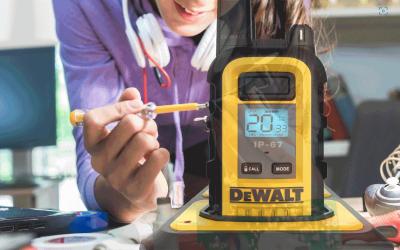As an Amazon Associate I earn from qualifying purchases.
After being produced for the first time several decades ago, walkie-talkies and two-way radios have gone a long way since their inception. Many people and children use walkie-talkies for recreational play, and dozens of companies and organizations still rely on its capabilities. Walkie-talkies have a wide variety of applications and may be used for a variety of purposes. When it comes to walkie-talkies of today, you have your pick of a wide variety of options, including forms, colors, sizes, and functionalities.
History of Walkie Talkies
The advent of the two-way radio
Don Hings, a Canadian, is credited with being the first person to create the walkie-talkie in 1937. Around the same time, numerous other inventors produced devices that were quite similar to the walkie-talkie. During his time working for CM&S, Hings designed and built his own portable radio signaling system. The gadgets, which were first designed to assist pilots in more successfully communicating with one another, were not previously known as “walkie-talkies.” When the Second World War started in 1939, it was immediately apparent how beneficial they were for troops who were really fighting. The early gadgets had a height of around 17 inches, weighted close to five pounds, and weighed close to five pounds. Metal was the typical material used in their construction. In the 1970s and 1980s, recreational users of all ages, including children and adults, were responsible for a significant increase in their popularity.
Wartime innovations
After a period of time spent doing research and development, Hings came up with a number of distinct types of portable radios to satisfy a wide variety of requirements. Of them, the Model C-58 Pack Set is the one that has become especially well-known and esteemed. It is estimated that tens of thousands of models were produced and distributed all over the globe. The C-58 had a number of different antennas and power supplies, voice scramblers to protect privacy and enhance security, and even a filter to remove battle noises from communications so that messages could be received loud and clear even during gunfire and engine noise. These features allowed the C-58 to have a wide range of capabilities. Due to its size, the Motorola SCR-300, which was one of the earliest two-way radio devices, could only be carried in a backpack. There are many who claim that the walkie-talkie was invented in 1933, however others dispute this assertion. On the other hand, these gadgets could only interact with one another via a code and drew electricity from passing automobiles. It is also not accurate to suggest that Al Gross created the gadget in 1938, since by that time, Hings was already making his radios.
What were walkie-talkies first known as?
Initially, the devices were known as wireless sets, pack sets, and two-way field radios; the term “walkie-talkies” wasn’t used to them until much later. Journalists were the ones who came up with the name “walkie-talkie” in order to enlighten the public about a phenomena that was relatively new at the time. During the early years of the product’s development, radio engineer Alfred J. Gross and the technical team at Motorola both had significant contributions to make to the process of expanding the capabilities of the gadget. During World War II, the armed forces of the United Kingdom, Germany, and the United States each used two-way radio systems. During the conflict, tank battalions and field artillery employed walkie-talkies as a means of communication. After the war, they were put to use to improve public safety, which was their primary function before they were put to use in the commercial and construction sectors.
How do walkie-talkies work?
Walkie-talkies normally include a speaker on one end and a microphone on the other, however in certain models, the speaker may also function as a microphone. In addition to that, they come with an antenna that is mounted on the very top of the device. A single radio channel is used by networks of half-duplex walkie-talkies. At any one moment, only one radio in the network is being used to converse, but all users are able to listen in on the conversation. Users may speak by pressing the button designated as the push-to-talk (PTT) button when they want to do so. This turns on the transmitter while shutting off the receiver. Alternatively stated: When using walkie-talkies or two-way radios that provide full duplex communication, it is feasible to send and receive transmissions at the same time.
Using a walkie-talkie
You and the other users of the walkie-talkie unit are required to tune to the same frequency band or channel in order to utilize the device. Radio waves, which move at the speed of light, are used to translate words into their electronic form. Electric currents are what allow the voice of the speaker to be played back via the loudspeakers. Talkers let people know that they are done by saying the phrase “over” and releasing the PTT button when they have completed speaking. The radio will now go back to the listening mode after this.
Walkie-talkies and two-way radios
Transceivers are another name for walkie-talkies, which are also known as two-way radios. This is due to the fact that, unlike regular radios, they are able to both send and receive radio transmissions at the same time, while standard radios can only send information in one direction. There are a lot of individuals who are curious about the distinction between walkie-talkies and two-way radios. A walkie-talkie is a kind of two-way radio, although not all two-way radios are walkie-talkies. This is a typical explanation, but it’s not quite accurate. This is mostly due to the fact that in order for a system to be considered a walkie-talkie, it must be handheld. Base stations that are fixed on walls and mobile radios that are installed inside cars are two types of two-way radios that should not be confused with walkie-talkies.
The highest possible level of coverage
When you are in the market for a walkie-talkie, it is imperative that you do your research and determine the greatest effective coverage area. You may be able to communicate with some systems from a distance of up to 50 miles away; but, in order to do so, specific requirements relating to your surroundings must be met. It’s possible that you won’t be able to converse properly farther than a mile away in certain situations.
Present-day walkie-talkies are two-way radios
It is possible to purchase walkie-talkies and two-way radios in today’s market that come equipped with a variety of cutting-edge capabilities. Some of these features include flashlights, SOS signals, and weather warnings. The majority of walkie-talkies that are used by members of the general public have a range of roughly two miles, and they weigh less than half a pound each. Numerous types of companies make use of two-way radios and walkie-talkies in their daily operations. They are an excellent choice for situations in which you may want to interact with others in the vicinity but do not have access to a mobile phone signal or Wi-Fi.
More contemporary features
Due to advancements in micro electronics, walkie-talkies have become much more compact over the last several decades. Some walkie-talkies designed specifically for individual use are now even more compact than a standard deck of playing cards. The terms “digital squelch” (DCS) and “analogue squelch” (CTCSS), as well as “trunking facilities” and “remote control of equipment like repeaters,” are examples of recently developed capabilities that are used by owners of two-way radios. It is also feasible to connect extra microphones and speakers, and thanks to the VOX capabilities, it is also able to operate the device without using your hands. The apparatus that is often ruggedized and has just a limited number of distinct frequencies when it is employed for either commercial or military applications. Over the course of the previous eighty years, the walkie-talkie has seen significant development; nonetheless, nobody really knows what the future holds.
After reading this article in its entirety, I hope you have a better understanding of the history of walkie talkies.



